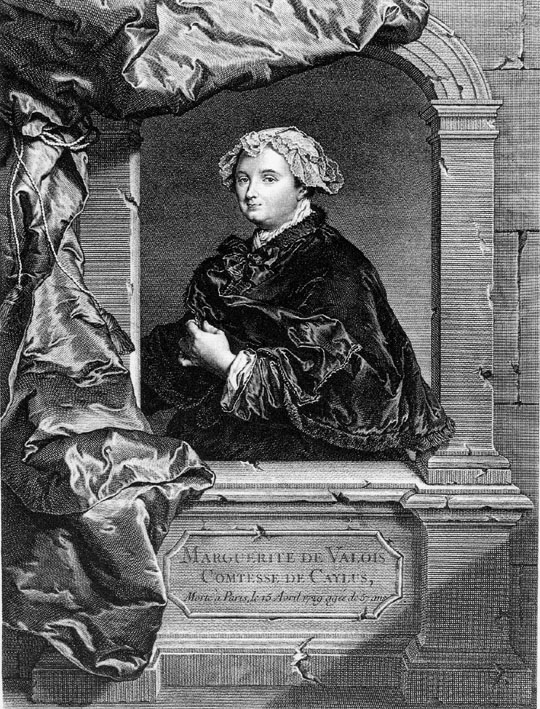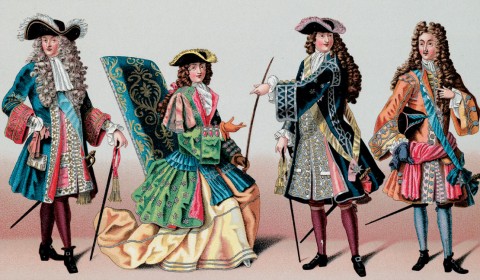Hortense Mancini, Duchesse Mazarin
Born on June 6 in 1646, Ortensia was the second youngest of the Mancini sisters, who along with their Martinozzi cousins were known as les Mazarinettes.
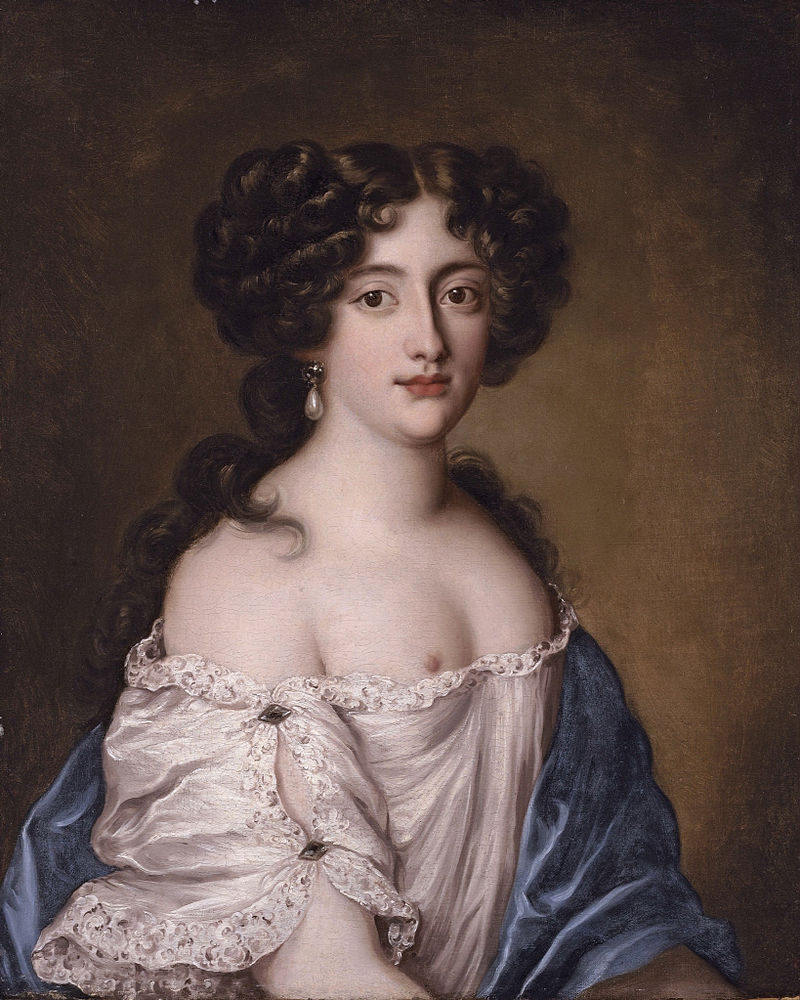
Ortensia was six years old as she arrived in France with her sisters and like them, swiftly adopted the French style of her name, Hortense. She was part of the second group of Mazarinettes to arrive in France. At the time of her arrival, her Martinozzi cousins Anne-Marie and Laura were as good as married, one to the Prince de Conti and the other to the Duc de Modène, while her oldest sister Laure was already married to Louis de Bourbon, a legitimised grandson of Henri IV. It was Laure who welcomed Hortense in France in 1653 and accompanied her to Aix, where she was taught French and courtly manners for a half a year, before their travel to Paris continued.
Beautiful Hortense swiftly became the favourite niece of Mazarin. Although she was said to be beautiful, witty and charming, but badly behaved with flamboyant manners, the whole court was enamoured with her and her sister Olympe.
In 1659, Cardinal de Mazarin rejected a marriage proposal for Hortense, he believed the candidate to have little in the way of prospects. It was the exiled Charles II of England. Mazarin realised this might have been a mistake, when Charles was reinstated as King of England only months later, thus made a counter-offer including a dowry of 5 million livres, but this time Charles refused. Hortense did not become Queen of England and Charles married Catherine of Braganza, but their ways would cross again several years later. Hortense’s hand was also requested by Charles-Emmanuel II de Savoie, his maternal grandparents being Henri IV and Marie de’ Medici, but arrangements fell through when Cardinal Mazarin refused to include the stronghold-castle of Pigneol in her dowry. For similar reasons, an offer made by the handsome Charles V Léopold de Lorraine was broken off as well.
Hortense did not become Queen of England, or Duchesse de Savoy, nor Duchesse de Lorraine et Bar, but Mazarin found another and more agreeable, in his opinion, candidate for the hand of his niece, who would proof to be a nightmare for her. Armand Charles de La Porte de La Meilleraye, one of the richest men of Europe, nephew of the late Cardinal de Richelieu, and Marquis de La Porte. He later became Marquis de La Meilleraye and then Duc de Mayenne and served as Grand Master of the French Artillery in 1646 or 1648. The marriage took place on the 1st March in 1661. The then fifteen-year-old Hortense became Duchesse Mazarin, her husband was made Peer of France. The Cardinal died only eight days after Hortense’s wedding and left her with a vast fortune, which included the Palais Mazarin in Paris.
Her freshly made Peer of France husband, was twenty-nine years old, Hortense only fifteen. Unfortunately for Hortense, the hubby proved to be rather jealous mixed with an over the top sense for morals. Hortense was young, bright, and popular, Armand-Charles was miserly and mentally unstable. His strange behaviour included preventing milk-maids from going about their job, in his mind the maids hands on the cows’ udders had strong sexual connotations, having all of his female servant’s front teeth knocked out to prevent them from attracting male attention, and chipping off and painting over all the “inappropriate bits” in his fantastic art collection. He forbade his wife to keep the company of other men or to be in their presence for longer than a few minutes, forbade her to wear mouches and gowns with low necklines, made midnight searches for hidden lovers in her rooms, insisted she spent a quarter of her day at prayer, asking forgiveness for various sins, and forced her to leave Paris and move with him to the country. Once, as fire broke out in the Palais Mazarin, he tried to prevent attempts to douse the flames and declared the attempts of firefighting were against God’s will. He also forbade the wet nurses to feed his children on Fridays and Saturdays, for it were the death-days of Lord, and even attempted later on to have the front teeth of his daughters removed, for the same reason he knocked those of his maids out.
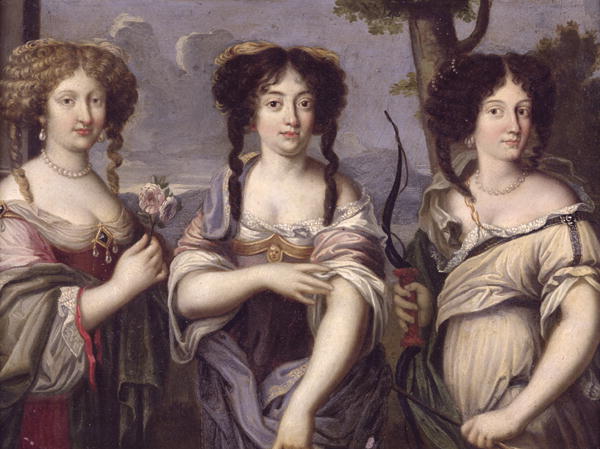
Obviously, the free-spirited Hortense became rather fed up with her husband’s behaviour and fled into the arms of someone else, Louis XIV one might think now, but it was Sidonie de Courcelles. A sixteen-year-old girl she started a lesbian affair with. Both of them were rather happy with each other until Armand-Charles noticed what was going on and put both of them into a convent. It was not as successful an attempt to save his wife’s soul as he had hoped, for both spent their days with playing pranks on the nuns by adding ink to the holy water, or setting their beds underwater, and climbing up the chimneys towards freedom. Despite their differences, Hortense and her husband had four children. Marie Charlotte being born in a carriage in 1662, as Armand-Charles forced Hortense to leave Paris with him for the country. Marie Anne de La Porte Mazarin born in 1663, Marie Olympe born in 1665 and Paul Jules, born one year later in 1666.
In January 1666, as Hortense had just given birth to Paul Jules and was eager to rejoin court life, her husband took all her jewellery from her while she was dressing and forbade her to leave. Hortense, in tears, thus tried to flee to the neighbouring property of her brother Philippe-Jules, Duc de Nevers, but her husband had the connection door in the garden closed up with bricks. What followed was witnessed by many happening to pass by. Hortense fled to the street to reach the property of her brother, under the cries of her husband urging the servants to take her captive. Hortense was once again locked up in a cloister, but freed with the help of her brothers-in-law and Armand-Charles banished from the Palais Mazarin.
Hortense finally made a bid to escape from her hellish marriage on the night of 13 June 1668, with help from her brother. Disguised in men’s clothing and on horseback, she left Paris in the midst of the night and boarded a carriage at its outskirts, that brought her to Lorraine and from there to Rome, to her sister Marie, now Princesse Colonna. Philippe-Jules joined them there shortly after and the exiled Chevalier de Lorraine as well. The latter had an eye on Hortense, but she had no particular interest in him and thus turned him down.
Hortense returned to France in 1670 and that in a not less scandalous manner. This time it was Marie fleeing from her abusive husband, afraid he might plan to poison her. Philippe-Jules asked for permission to bring both her and Hortense to France with him, as he returned to marry a niece of Madame de Montespan. Louis XIV declared himself protector of both sisters and the plan went underway. Marie and Hortense left Rome, wearing men’s garments under their travelling garments. They went to Monaco, where a boat, chartered by their brother, was waiting for them. The voyage was delayed by Hortense giving birth to a child obviously not from her husband, which lead him thus to spread rumours of a incestual relationship between Hortense and Jules-Philippe. Louis XIV intervened again and ordered Armand-Charles to refrain from stating accusations like this, then granted Hortense an annual pension of 24000 livres. Her former suitor the Duc de Savoy also declared himself her protector and Hortense retired to Chambéry, in Haute-Savoie, where she establish her home as a meeting place for authors, philosophers, and artists.
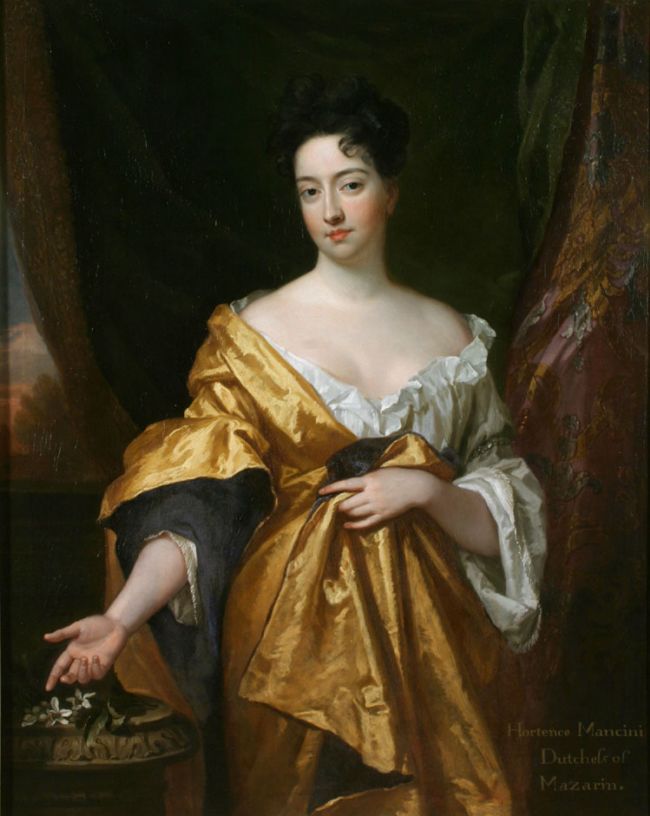
After the death of her Savoyan protector in 1675, Hortense had no source of income anymore, since her husband froze all of her income, including the pension from Louis XIV. The English ambassador to France, Ralph Montagu, aware of Hortense’s desperate situation, enlisted her help in increasing his own standing with Charles II. He hoped she would replace the King’s current mistress, Louise de Kerouaille, Duchess of Portsmouth. Hortense was willed to try and disguised herself as a man again to travel to England, under the pretext of a visit to her young niece, Mary of Modena, the new wife of Charles’ younger brother, James, Duke of York.
It did not take long until the plan succeeded. Already by mid 1675, Hortense was a visitor of Charles’ bed and he provided her with a pension of £4,000, enabling her to live a comfortable life.
Hortense’s time in England was not less wild than her time in France. She took several lovers, including Anne, Countess of Sussex, a daughter of Charles and Barbara Castlemaine, earning her the nickname the ‘Italian Whore‘. The two had a very public fencing match in St. James’s Park, only wearing their nightgowns. Another of Hortense’s lovers was Louis I, Prince of Monaco, the hubby of Catherine-Charlotte de Gramont, a former mistress of Louis XIV. Charles gave her a good scolding and cut off her pension…but within a couple of days he repented and restarted the payments. She and Charles remained friends, but Louise de Kerouaille returned to the position of maitresse-en-titre.
After the death of Charles II, the new King of England James II provided for Hortense and allowed her to remain in England. She did so even as James fled England and William and Mary rose to power. Hortense died in Chelsea on July 2 in 1699, aged fifty-three.
“Now died the famous Duchess of Mazarin. She had been the richest lady in Europe; she was niece to Cardinal Mazarin, and was married to the richest subject in Europe, as was said; she was born at Rome, educated in France, and was an extraordinary beauty and wit, but dissolute, and impatient of matrimonial restraint, so as to be abandoned by her husband, and banished: when she came to England for shelter, lived on a pension given her here, and is reported to have hastened her death by intemperate drinking strong spirits. She has written her own story and adventures, and so has her other extravagant sister, wife to the noble family of Colonna.” John Evelyn
After Marguerite de Valois, Hortense and her sister Marie, were the first women in France to put their memoirs into print. Hortense may have helped her demise by consummating large amounts of alcohol, perhaps because her French husband never let her live in peace, even as she lived in England. Armand-Charles even managed to continue the drama after her dead, by seizing her coffin and taking her death body with him during his travels through France. Until he was ordered to bury her by the King.



